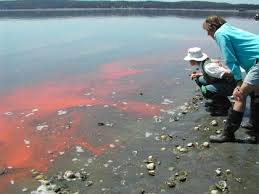Is the red tide in Hermanus harmful to swimmers?
 The red tide band currently visible in Walker Bay, Hermanus covers the entire West Coast from Doring Baai southwards into False Bay and Walker Bay as far east as Cape Agulhas.
The red tide band currently visible in Walker Bay, Hermanus covers the entire West Coast from Doring Baai southwards into False Bay and Walker Bay as far east as Cape Agulhas.  Although members of the public are strongly advised not to collect and/or eat any mussels or filter organisms such as red bait and oysters in the affected area, it does not pose any danger to people swimming in the ocean.
Although members of the public are strongly advised not to collect and/or eat any mussels or filter organisms such as red bait and oysters in the affected area, it does not pose any danger to people swimming in the ocean.
Red Tides are natural phenomena and usually occur as a result of abnormally high production of plankton following periods of coastal up-welling. Shellfish such as mussels, clams, bait and oysters are particularly vulnerable. The bloom causes the ocean to have a red colour during the day, while it appears luminescent at night. Grant Pitcher, the red tide specialist at the department of fisheries, identified the bloom as Gonyaulax polygramma. It’s a non-toxic species, but if the concentration becomes too high, it could cause fish mortalities through bloom decay and anoxia.
Grant Pitcher, the red tide specialist at the department of fisheries, identified the bloom as Gonyaulax polygramma. It’s a non-toxic species, but if the concentration becomes too high, it could cause fish mortalities through bloom decay and anoxia.
Members of the public are asked to call the department’s Red Tide Information answering service on (021) 434 4457 to get updates on the tide’s status.
WHAT IS A RED TIDE?
The term red tide is misleading, because discolourations of the water may appear brown, orange, purple or yellow, as well as red. These discolourations are caused by dense concentrations of the microscopic plants of the sea, the so-called phytoplankton. The discolouration varies with the species of phytoplankton, its pigments, size and concentration, the time of day and the angle of the sun.

Most red tides along the South African coast are caused by a group of phytoplankton known as dinoflagellates. These single-celled organisms are able to swim short distances by means of two whip-like appendages called flagella. Their ability to swim contributes to their success as red tide organisms.
WHAT TRIGGERS A RED TIDE?
Red tides, like bioluminecence, usually occur along the Cape west or south coasts in late summer and autumn. The prevailing southerly winds at this time of year cause cold, nutrient-rich water to rise up from the deeper regions of the ocean to the surface, a process known as upwelling. The rapid increase in dinoflagellate numbers, sometimes to millions of cells per litre of water, is what is known as a "bloom" of phytoplankton. Concentration of this bloom moved by wind and currents, as well as the dinoflagellates' ability to swim to the surface,, lead to the formation of a red tide.

Red tides are therefore not a result of sudden population explosions of phytoplankton but result from confinement or concentration of phytoplankton following normal population increases to such an extent that they discolour the water.
The conditions will turn unfavourable when the nutrients are depleted or the bloom is dispersed by wind and currents which will then cause the dinoflagellates to dormant cysts and sink to the sea floor.
WHAT ARE THE CONSEQUENCES OF RED TIDE?
Most red tides represent useful contributions to plankton production but some periodically produce harmful results.
 PHYSICAL DAMAGE
PHYSICAL DAMAGE
Dense concentrations of red tide organisms can suffocate fish by clogging or irritating their gills, so that they cannot extract sufficient oxygen from the water. 
OXYGEN DEPLETION
Red tides may also kill indirectly by depleting the oxygen dissolved in the water caused by huge populations of decomposed bacteria. This cause a bad smell accociated with red tide. Best known are the rock lobsters the crawl from the sea. Another such an event was observed in St Helena Bay in when white mussels

DIRECT POISONING
Toxins produced by certain dinoflagellates are some of the most potent poisons known to man. The most notorious of the dinoflagellate toxins are the neurotoxins which disrupt normal nerve functions. Virtually the entire adult mussel population in the Elands Bay area was destroyed by the dinoflagellate Gonyaulax catenella in 1980, while 30 tons of abalone were washed up in the HF Verwoerd Marine Reserve in 1989.
 A CASE IN TIME
A CASE IN TIME
Aerosol (air-born) Toxins
In the summer of 1995-96, South Africa experienced a severe aerosol toxin problem in False Bay which later spread to the coastal resort of Hermanus in Walker Bay. Beachgoers and seaside residents were overcome by the discomfort of coughing, burning of the nasal passages, difficulty in breathing, stinging eyes and irritation to the skin. Although the discomforts experienced were considerable, symptoms were usually relieved upon leaving the area, and no long-term effects were noted. The aerosol toxin was linked to the presence of the bloom of a toxic dinoflagellate species Gymnodinium, first recorded in False Bay in 1988. Faunal mortalities were however small, with the exception of the larval mortalities experienced by several land-based abalone farmers in the Walker Bay area.
Source acknowledgements: Irma van der Vyver and Dr Grant Pitcher
Call us and schedule your listing today! Contact Us
Copyright © 2025 Hermanus Online Magazine. Web Development by Jaydee media.

